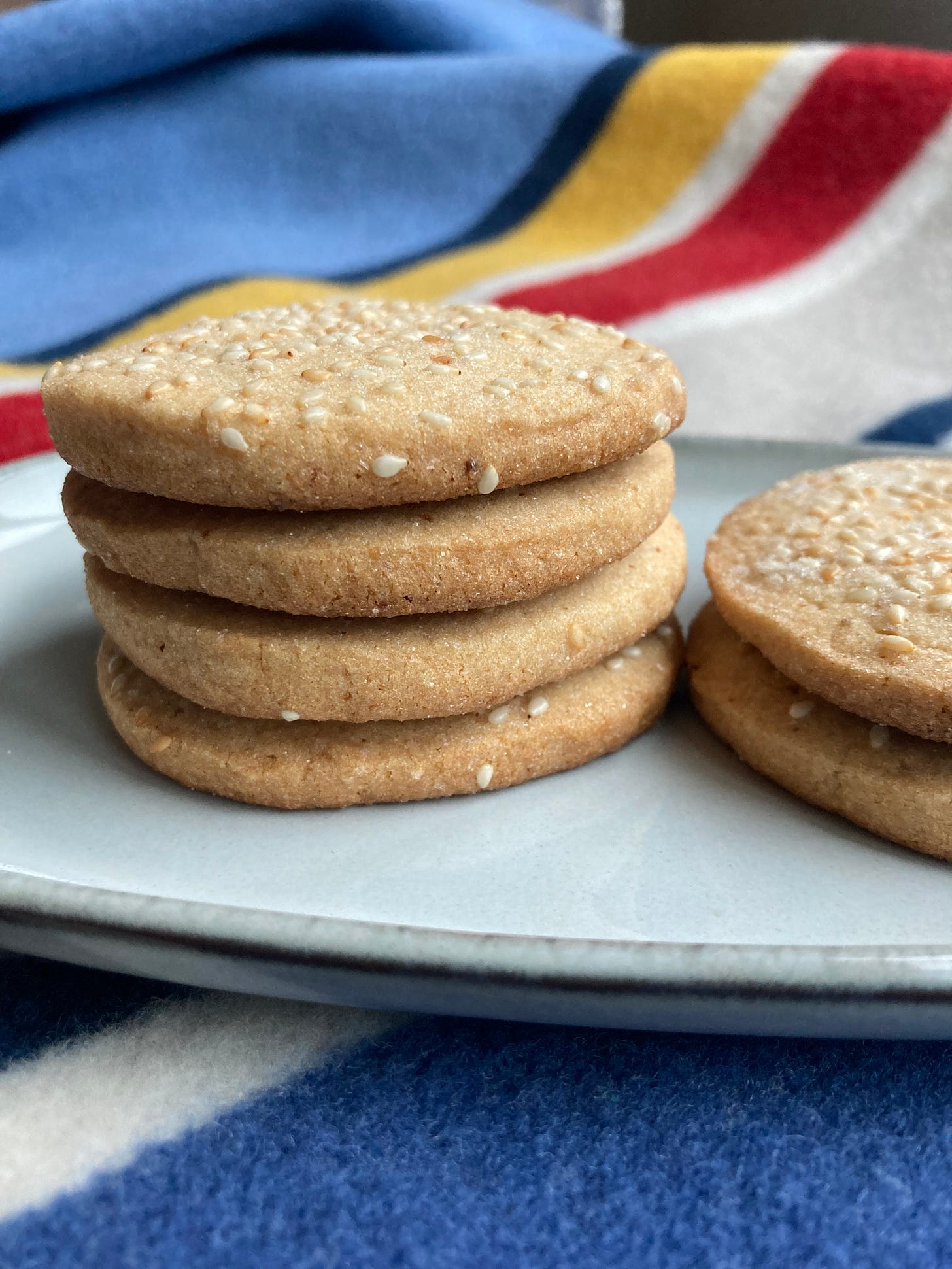(Mis)fortune cookie
Fortune cookies predate my current fixation on abstract celestial guidance but are no less relevant to my personal cosmology. A message of support AND a dessert? Iconic. But it turns out that fortune cookies have a dark and mysterious history that makes them doubly iconic and possibly even the slightest bit tragic.
Despite the ubiquitous association of fortune cookies with Chinese food in America, they actually originate from a Japanese confection called tsujiura senbei. These ancestral cookies (really, crackers) are sold to this day and are particularly popular in Kyoto. Flavored with miso and sesame, they are savory in contrast to their sugary, vanilla-spiked American cousins. There’s a metaphor in there somewhere.
Despite a positively Ellis Island-ian cloud of ambiguity, some accounts confidently cite the earliest example of the American tsujiura as belonging to Makoto Hagiwara. He was the landscape designer responsible for the Japanese Tea Garden at Golden Gate Park in San Francisco, where the heavily modded tsujiura senbei were served. He adapted the traditional recipe to the American palate, which he was accustomed to serving via his previous career as a Chinatown restauranteur.
From there, the popularity of the fortune cookie, née tsujiura senbei, boomed. I conjecture that the avalanching popularity of the cookie created a market for its creation by other confectioners and became synonymous with Japanese food more broadly. It then became standard practice for Japanese restaurants to serve fortune cookies at the end of the meal (side note: postprandial dessert is an American concept; sweets tend to be served away from meals, with tea, in Japan).
And then came WWII and the incarceration of Japanese immigrants and Japanese-American citizens. Restaurant owners and workers were forced to surrender their businesses and positions, leaving their primarily Chinese coworkers and partners to continue in their absence (another side note: Asian immigrants tended to live and work in close proximity because racism and because, further, xenophobia). So, there followed some cultural muddying of culinary practices and fortune cookies became more synonymous with Chinese food than Japanese.
You know what, good for them. I’m sure there were elements of imperialist anti-Chinese racism perpetrated by Japanese bosses, NOT THAT THIS IMPLIES THAT THE JAPANESE DESERVED TO BE SENT TO CONCENTRATION CAMPS, OK? I hope I don’t need to qualify this as a descendent of the survivors, but we’re only one day out of Mercury retrograde so I’m hedging my bets. But anyway, something we don’t talk enough about is the horrific legacy of the Japanese imperial violence in Asia and the South Pacific. I guess because anime is so cool? But that’s a topic for another cookie recipe.
Through the refiner’s fire that is white ignorance and the violent chauvinism of the American empire, tsujiura senbei became fortune cookie became whitewashed Japanese food turned Chinese. A little joyless to learn the history, isn’t it? If you need to concuss yourself to forget this and enjoy the purity of your pre-awareness fortune cookie experience, I won’t blame you.
Herein, however, lies an opportunity to pay homage to this little treat that harkens back to its origins with miso and sesame. Enjoy them with tea and ponder the truly weird state of affairs that led us to this moment.
Tsujiura senbei shortbread
2 sticks butter, at room temperature
160g sugar
80g white miso paste (red or any other color are fine, too)
30g toasted sesame oil
2 egg yolks
1/2 tsp kosher salt
1/2 tsp baking powder
150g cornstarch
100g rice flour
50g AP flour
50g kinako (soybean flour - this can be found at Asian grocers; replace with 25g rice flour if unavailable)
1/4 cup granulated sugar
2 Tbsp toasted sesame seeds
Cream together the butter and sugar until light in color and texture. Add the miso paste, sesame oil, and egg yolks and stir to combine until homogenous.
Combine the remaining ingredients, besides the additional sugar and sesame seeds, in a separate bowl and whisk to combine. Slowly add this to the butter mixture and stir just until combined.
Transfer the dough to a waiting sheet of parchment paper and form into a log. This can be accomplished in a number of ways that are extremely difficult to describe. But here goes: gather the dough together at the center of the parchment and “taco” it so that both ends are in one hand. Then take a bench scraper and use the blade to corral the dough into the tubular shape formed by the paper. Scrape while holding the paper taut and it will cohere into a columnar mass. Easy, right? You’re also welcome to form the dough into 30g balls at this stage. Regardless of how you’re corralled the dough, freeze until firm - about an hour.
When read to bake, preheat your oven to 350ºF and line a baking sheet with more parchment paper. Either cut 1/4” slices from your frozen dough log or procure your (dough) balls. Stir together your sugar and sesame seeds in a shallow bowl. Toss your discs or balls into the mix and embed the sugar and sesame into them. Place onto the baking sheet. If the dough is in balls, use the bottom of a glass to press them into rounded shapes. They won’t spread much in the oven; bear this in mind while placing.
Bake for 12 minutes or until golden brown around the edges.




